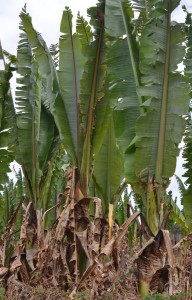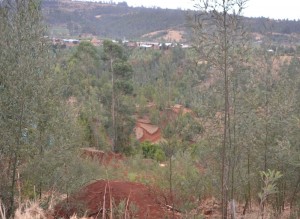False Bananas: The Potential for Food Security in Ethiopia
May 17th, 2013 | By admin | Category: Biodiversity/ConservationBy Suzanne York, www.howmany.org
As climate change becomes more of a basic fact of life for many people around the world, one way to adapt is to tap into traditional and ancestral knowledge and practices, especially as it pertains to agriculture. In Ethiopia, one crop with potential is the false banana.
Officially called enset, this root crop is often referred to as false banana due to its striking resemblance to the banana plant. Enset is highly drought resistant, crucial in a region that has suffered decades-long droughts. And in a world beginning to adjust to 400 parts per million of carbon dioxide in the atmosphere, and hence more severe and unexpected climate impacts, turning to local crops may provide some hedge against the coming changes.
“The Tree Against Hunger”
A report by the American Association for the Advancement of Science (AAAS) has called enset the “Tree Against Hunger”. It is grown mainly in the highlands of southern Ethiopia, and was likely domesticated 10,000 years ago. The trunk, called a “pseudostem,” serves as the food source. It can be harvested any time of the year.
Enset is used not only as a staple food, but also as fiber for ropes and other materials. An article written for Survival International quoted an Ethiopian woman as saying that “Enset is incomparable with any other crop. It’s used for everything: fences, curtains, seat cushions, bags, string, rope, animal feed. We can’t think of our lives outside of enset.”
Some experts have noted that the deep roots of the false banana plant endow it with greater resilience to drought than cereal crops like wheat, and therefore provides greater food security to those who grow it.
A Means to Offset Environmental Degradation
Ethiopia suffers from extreme soil erosion, much of it due to forests cleared for farmland and livestock and trees cut down for charcoal and timber. The resulting deforestation has led to severe environmental degradation. The false banana offers some hope for farmers to overcome the impact of soil erosion.
Development organizations such as Self Help Development International have found that in places where enset is grown, the native soil has been improved due to long-term applications of manure, natural mulching of leaf and stem residues, and rainfall that is captured from the plants large leaves. Additionally, enset plants are used in mixed cropping, providing shade and acting as a windbreak for other crops such as coffee (Ethiopia’s largest export commodity) and potatoes, as the tree can grow as high as 30 feet.
A Silver Bullet?
Despite being a traditional, staple crop of Ethiopia, there are some questions about enset’s durability during a prolonged drought. The past decade has seen a decline in enset production, attributed to rising temperatures and changing rain patterns, with plants that are stunted or more susceptible to disease. Still, the authors of the AAAS report noted that “Farmer interviews suggest that those populations dependent upon enset have never suffered from famine, even during Ethiopia’s tragic drought and famine prone decades of the 1970s and 1980s.” This particular report hypothesized that “once enset is established it can tolerate occasional years of unusually low total rainfall or a short rainy season.”
The jury is still out, but many Ethiopians and others believe in enset’s potential (see this short video by Action Ethiopia on how women in Guraghe harvest enset). More studies should be undertaken, with more on-the-ground tests and discussion with native inhabitants. The Ethiopian government declared enset a “national crop” in the late 1990s, prompting greater research and development regarding the plant’s potential.
Changes in climate should and will spur more exploration and consideration of traditional crops and practices. The versatile false banana plant is one that should be high on the list.
Suzanne York is a senior writer with the Institute for Population Studies and was in Ethiopia for a population, health, and environment conference in March 2013 and visited the southwest Guraghe region where enset is grown.
[photo credit: Suzanne York]


